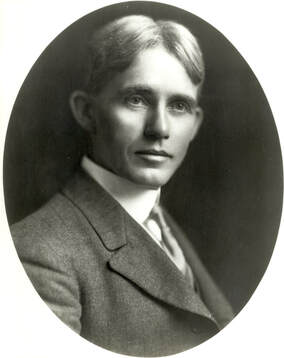Portrait of J.B. Johnston
The J. B. Johnston Club is named after one of the founding fathers of the American school of Comparative Neuroanatomy. A contemporary of Herrick and Coghill, John Black Johnson was born in a small town in Ohio. He enrolled at the University of Michigan to study Zoology where he received his Baccalaureate in 1893 and his PhD in 1899 for his work on “The brain of Acipenser: A contribution to the Morphology of the Vertebrate Brain”.
With the aid of Oliver Strong at the Marine Biological Laboratory, he mastered the Golgi staining method, which he used to produce detailed comparative neuroanatomical descriptions of the brains and cranial nerves of vertebrates. His work included the description of the organization of cranial nerves, their subdivisions into somatic and visceral components as well as their relationship with the ‘correlative’ centers in the brain.
J. B. Johnston continued his work at the University West Virginia, and it was while he was there that his seminal book “The Nervous System of Vertebrates” was published in 1906, following a sabbatical to the Naples Zoological Station and University of Freiburg. The book’s presentation of the basic patterns of organization of the nervous system across vertebrates provided the much needed theoretical and conceptual frameworks that were adopted by the next generation of comparative neuroanatomists. J. B. Johnston was among the early pioneer neuroscientists who, through the use of electrophysiology, experimentally tested the functional hypotheses that were derived from anatomical observations. This experimental approach has become one of the most valuable for understanding of the functional organization of the brain, and one that still defines many areas of modern neuroscience.
J. B. Johnston finally settled at the University of Minnesota in 1907, where he was named Professor of Comparative Neurology in 1909. The later years of his career were dedicated to University Administration making substantial contributions to the educational system.
Historical Documents: J.B.Johnston and the J.B. Johnston Club
J.B. Johnston Biography
J.B. Johnston Publications
JBJC History (Composed by Mary Sue Northcutt, 1989)
Acknowledgments:
We wish to acknowledge the help of our membership, in particular Mark Braford and Catherine McCormick for preserving and collating this important historical dataset.
Sources
Butler, AB, Molnár, Z (1998): Development and evolution in nervous systems: development and evolution of ideas Trends in Neurosciences 21: 177-178
Magoun, HW (2003): American neuroscience in the twentieth century. Lisse, Swets and Zeitlinger.
University of Minnesota Archives
The J. B. Johnston Club is named after one of the founding fathers of the American school of Comparative Neuroanatomy. A contemporary of Herrick and Coghill, John Black Johnson was born in a small town in Ohio. He enrolled at the University of Michigan to study Zoology where he received his Baccalaureate in 1893 and his PhD in 1899 for his work on “The brain of Acipenser: A contribution to the Morphology of the Vertebrate Brain”.
With the aid of Oliver Strong at the Marine Biological Laboratory, he mastered the Golgi staining method, which he used to produce detailed comparative neuroanatomical descriptions of the brains and cranial nerves of vertebrates. His work included the description of the organization of cranial nerves, their subdivisions into somatic and visceral components as well as their relationship with the ‘correlative’ centers in the brain.
J. B. Johnston continued his work at the University West Virginia, and it was while he was there that his seminal book “The Nervous System of Vertebrates” was published in 1906, following a sabbatical to the Naples Zoological Station and University of Freiburg. The book’s presentation of the basic patterns of organization of the nervous system across vertebrates provided the much needed theoretical and conceptual frameworks that were adopted by the next generation of comparative neuroanatomists. J. B. Johnston was among the early pioneer neuroscientists who, through the use of electrophysiology, experimentally tested the functional hypotheses that were derived from anatomical observations. This experimental approach has become one of the most valuable for understanding of the functional organization of the brain, and one that still defines many areas of modern neuroscience.
J. B. Johnston finally settled at the University of Minnesota in 1907, where he was named Professor of Comparative Neurology in 1909. The later years of his career were dedicated to University Administration making substantial contributions to the educational system.
Historical Documents: J.B.Johnston and the J.B. Johnston Club
J.B. Johnston Biography
J.B. Johnston Publications
JBJC History (Composed by Mary Sue Northcutt, 1989)
Acknowledgments:
We wish to acknowledge the help of our membership, in particular Mark Braford and Catherine McCormick for preserving and collating this important historical dataset.
Sources
Butler, AB, Molnár, Z (1998): Development and evolution in nervous systems: development and evolution of ideas Trends in Neurosciences 21: 177-178
Magoun, HW (2003): American neuroscience in the twentieth century. Lisse, Swets and Zeitlinger.
University of Minnesota Archives

